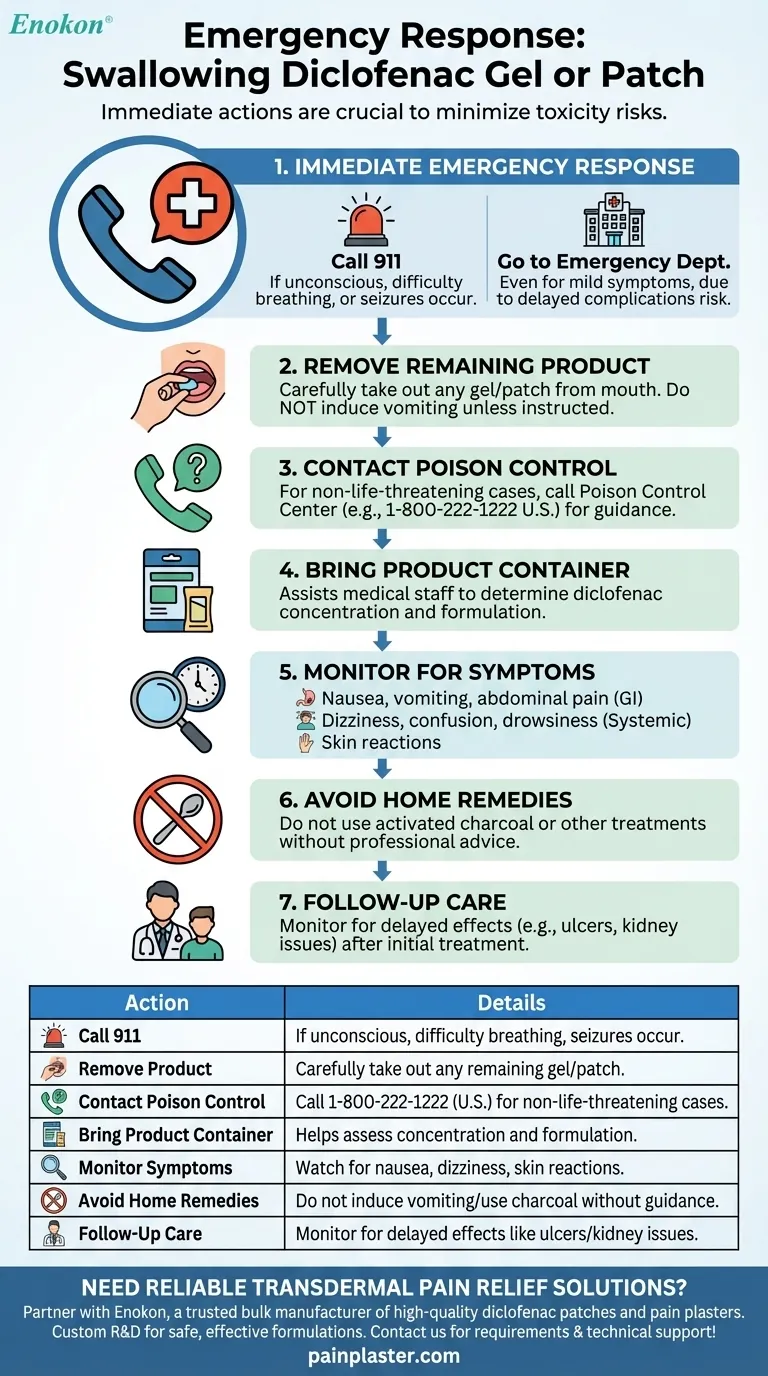If someone swallows diclofenac gel or a Diclofenac Patch, immediate action is crucial due to the risk of systemic toxicity, gastrointestinal irritation, or other complications. The primary steps involve seeking emergency medical help, contacting poison control, and removing any remaining product from the mouth. The severity of symptoms dictates whether to call 911 or proceed to the emergency department. Bringing the product container aids medical professionals in assessing the situation accurately.

Key Points Explained:
-
Immediate Emergency Response
- Call 911 for life-threatening symptoms: If the person is unconscious, having difficulty breathing, or experiencing seizures, emergency services must be contacted immediately.
- Go to the emergency department: Even if symptoms seem mild, diclofenac ingestion can lead to delayed complications like gastrointestinal bleeding or kidney damage.
-
Remove Any Remaining Product
- If the patch or gel is still in the mouth, carefully remove it to prevent further absorption. Avoid inducing vomiting unless instructed by a medical professional, as this could worsen irritation.
-
Contact Poison Control
- If symptoms are not immediately life-threatening, call a poison control center (e.g., 1-800-222-1222 in the U.S.) for guidance on next steps. They can assess the risk based on the amount ingested and provide tailored advice.
-
Bring the Product Container
- Providing the original packaging helps medical staff determine the concentration of diclofenac, formulation type (gel/patch), and any additional ingredients that may influence treatment.
-
Monitor for Symptoms
- Even if initial symptoms are mild, watch for:
- Nausea, vomiting, or abdominal pain (indicating gastrointestinal irritation).
- Dizziness, confusion, or drowsiness (signs of systemic absorption).
- Skin reactions (if the gel was ingested, topical sensitivity may still occur).
- Even if initial symptoms are mild, watch for:
-
Avoid Home Remedies
- Do not administer activated charcoal or other treatments without professional advice, as diclofenac’s absorption kinetics vary by formulation.
-
Follow-Up Care
- After initial treatment, monitor for delayed effects like ulcers or kidney dysfunction, especially in high-risk individuals (e.g., elderly or those with pre-existing conditions).
By acting swiftly and methodically, the risks associated with diclofenac ingestion can be minimized. Always prioritize professional medical evaluation over home interventions.
Summary Table:
| Action | Details |
|---|---|
| Call 911 | If unconscious, difficulty breathing, or seizures occur. |
| Remove Product | Carefully take out any remaining gel/patch from the mouth. |
| Contact Poison Control | Call 1-800-222-1222 (U.S.) for non-life-threatening cases. |
| Bring Product Container | Helps medical staff assess diclofenac concentration and formulation. |
| Monitor Symptoms | Watch for nausea, dizziness, or skin reactions. |
| Avoid Home Remedies | Do not induce vomiting or use activated charcoal without guidance. |
| Follow-Up Care | Monitor for delayed effects like ulcers or kidney issues. |
Need reliable transdermal pain relief solutions? Partner with Enokon, a trusted bulk manufacturer of high-quality diclofenac patches and pain plasters. Our expertise in custom R&D ensures safe, effective formulations tailored to your needs. Contact us today to discuss your requirements and benefit from our technical support!
Visual Guide

Related Products
- Asthma Cough and Pain Relief Patch for Adults and Kids
- Far Infrared Deep Heat Relief Patches Medicated Pain Relief Patches
- Menthol Gel Pain Relief Patch
- Icy Hot Menthol Medicine Pain Relief Patch
- Far Infrared Heat Pain Relief Patches Transdermal Patches
People Also Ask
- How does capsaicin work in the Reliever Patch? A Drug-Free Solution for Targeted Pain Relief
- How should missed doses of the Reliever Patch be handled? Safe Usage Guidelines
- What makes the cough relief patch a convenient option for managing coughs? A Mess-Free, On-the-Go Solution
- How does the far infrared technology in the cough relief patch work? Enhance Natural Ingredient Delivery
- What role do natural ingredients and acupoint stimulation play in a cough relief patch? Synergistic Relief Explained















